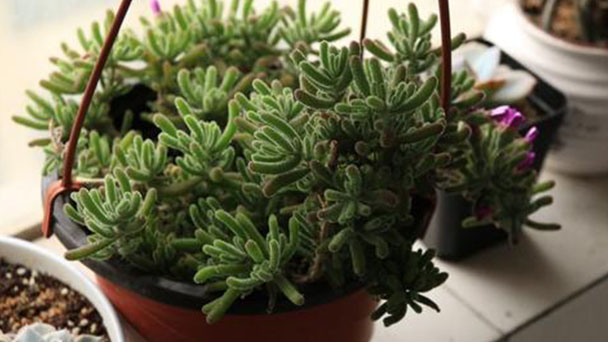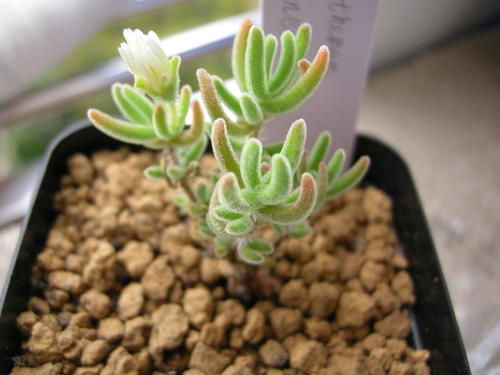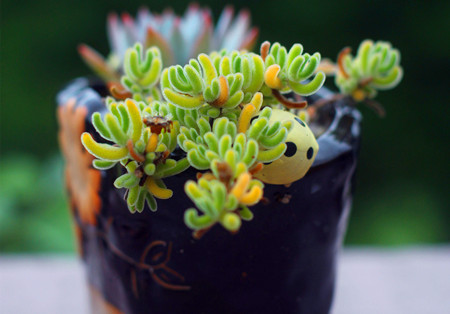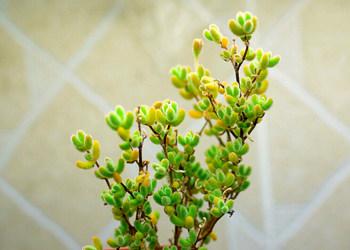Dicrocaulon ramulosum profile
Written by Maggie
Mar 02 2021

Dicrocaulon ramulosum is a popular species of succulent plants, belonging to the family Apricaceae, with fleshy leaves arranged like rabbit ears and ornamental value. Dicrocaulon ramulosum is mainly distributed in southern Africa, Oceania and the central Pacific region and other tropical arid areas.
Dicrocaulon ramulosum picture

Morphological characteristics of Dicrocaulon ramulosum
Dicrocaulon ramulosum is a Perennial succulent herb, prostrate growth or densely clustered into small shrubby; Plant height is 10-25 cm, plant width 15-27 cm; Old stem is light brown, tender stem green, fine, are covered with very fine soft villi. Leaves of dicrocaulon ramulosum are green, fleshy, red in good light, 1-2 cm long, 0.3-0.5 cm wide; Opposite, basally connate, surface covered with minimal transparent vitreous particles, leaf apex thickened, root system often germinated at base of leaf close to ground. Flowers of Dicrocaulon ramulosum are large, Daisy - shaped, white, with long erect stems, spring. Capsule is fleshy, brown seeds, very small.
Ecological habits of Dicrocaulon ramulosum
Dicrocaulon ramulosum likes sufficient sunshine, warm and dry, afraid of waterlogged concealment, avoid extreme drought or scorching sun exposure. Dicrocaulon ramulosum is suitable to grow in neutral, well drained, porous sandy loam soil with more particles.
The distribution region of Dicrocaulon Ramulosum
Dicrocaulon ramulosum is found only in the northern Cape Province of South Africa.
How to grow and care for Dicrocaulon ramulosum
Fertilization
Dicrocaulon ramulosum seeds can be fertilized one to two months after germination. It should be noted that the fertilizer to be bought as far as possible to dilute, still uses the way of immersion fertilization. If you have no experience in fertilizing, you can also stop fertilizing. When the seedlings of Dicrocaulon Ramulosum have grown a lot, they should be potted in time so that they can absorb sufficient growth nutrients. Potted seedlings should not be watered until a week later.
Soil
The soil used for sowing should be loose and breathable with good water retention effect. It is best to use mixed soil, which can be composed of vegetative soil, coal ash, sand, plant ash and perlite, with a ratio of 4:4:2:1:1. In addition, vegetative soil, vermiculite and perlite can be mixed in a ratio of 4:6:1.
Flower pot
When choosing a seedling pot for Dicrocaulon ramulosum, it's better to choose an earthenware pot with good air permeability rather than a ceramic one. Because only the flowerpot is breathable, pot soil is easy to dry, and is conducive to the germination of seeds. If you can't find an earthen pot, you can choose an earthenware one. When the pot is ready, it's time to fill Dicrocaulon ramulosum with soil. The soil should be about eight to ten centimeters thick, and it should have two three-centimeter edges.
The light
Dicrocaulon ramulosum likes plenty of sun but can't get it, so it shades its young plants in the summer. In hot weather, place a water tray at the bottom of the pot and cover it with shallow water to keep it moist .During the cold winter months, Dicrocaulon ramulosum should be moved to a sunny corner and the soil should be kept slightly moist.

Propagation of Dicrocaulon ramulosum
Sow
Before planting, Dicrocaulon ramulosum spreads a layer of sand evenly on the surface of the soil, wetting the sand with a watering can, and then spreads the seeds evenly over the sand bed. Because the seeds of Dicrocaulon ramulosum are small, you can also mix the planting soil with fine sand before sowing.In order to increase the germination rate, the sowing site needs to be dense and no soil should be applied after sowing.
Cuttings
Take mature branches of robust Dicrocaulon ramulosum, cut into 5-10 cm long sections, directly inserted into the sand bed, maintain a certain humidity, about 15-20 days can take root.
Functions of Dicrocaulon Ramulosum
The leaves are very fleshy and arranged like rabbit ears. Dicrocaulon ramulosum is a popular variety of succulent plants with simple maintenance, easy propagation, peculiar shape and high ornamental value.
Dicrocaulon ramulosum seed collecting:
Allow pods to dry on plant; break open to collect seeds
Allow seed heads to dry on plants; remove and collect seeds
Properly cleaned, seed can be successfully stored.

Latest Updated
- Benefits of Bugleweed - 7 Science-backed Health Benefits
- Bugleweed Dangers & Side Effects - Is It Poisonous?
- How to Plant Evergreen Trees - What You Should Know
- When to Plant Evergreens - Grow Guide for Evergreen Trees
- 12 Wonderful Evergreen Shrubs for Your Garden
- 12 Popular Evergreen Plants with Pictures for Beginners
- When And How To Prune A Lilac Bush Like a Pro
- How to Grow & Care for Lilac Vine (Hardenbergia Violacea)
- Japanese Lilac Tree (Syringa Reticulata) Care & Propagation Guide
- Shumard Oak Pros and Cons - What to Know
Popular Articles
- Winter maintenance of Antirrhinum Majus
- How to Grow Terminalia Mantaly Tree
- How to Grow and Care for Crossostephium Chinense
- How to grow Antirrhinum Majus in spring
- Peristeria Elata (Dove Orchid) Profile: Info & Care Guide
- Underwatered Snake Plant (Sansevieria Trifasciata) - Signs And How To Fix
- How to Care for Brazilian Jasmine Plant (Mandevilla Sanderi)
- How to Grow & Care for Graptopetalum Purple Delight in Summer
- Rosa Chinensis (China Rose): Plant Growing & Care Tips
- How to Care for Baby Sun Rose (Aptenia Cordifolia)